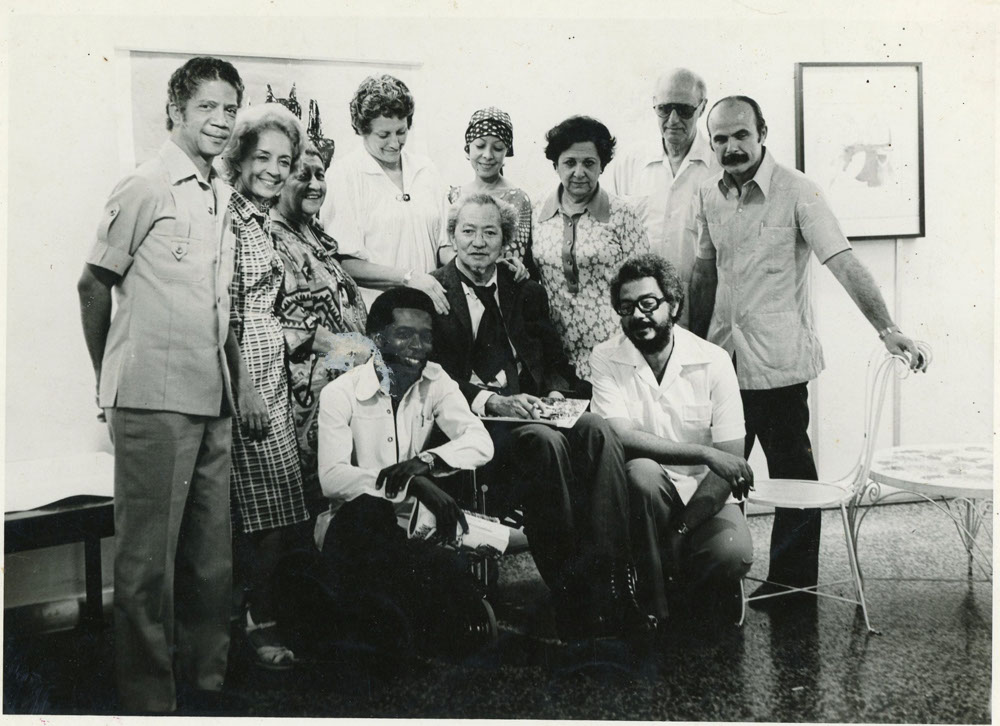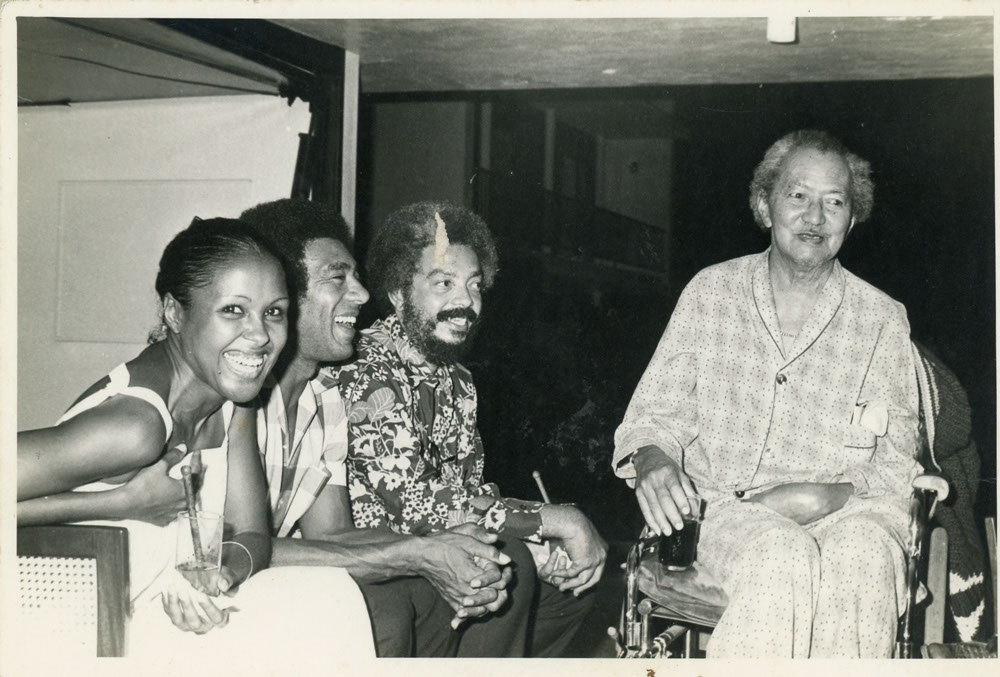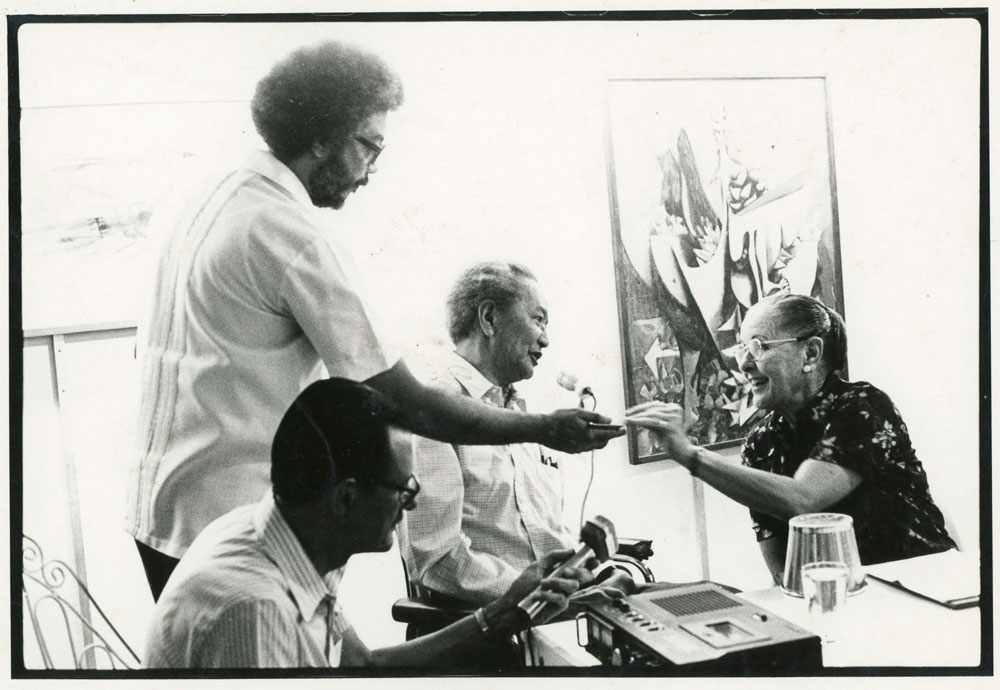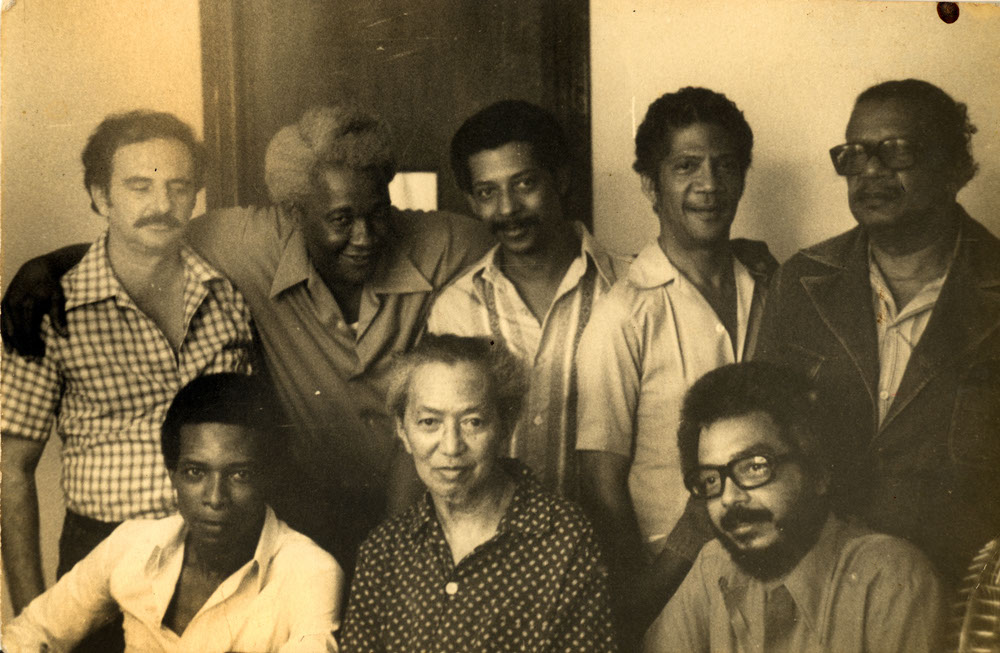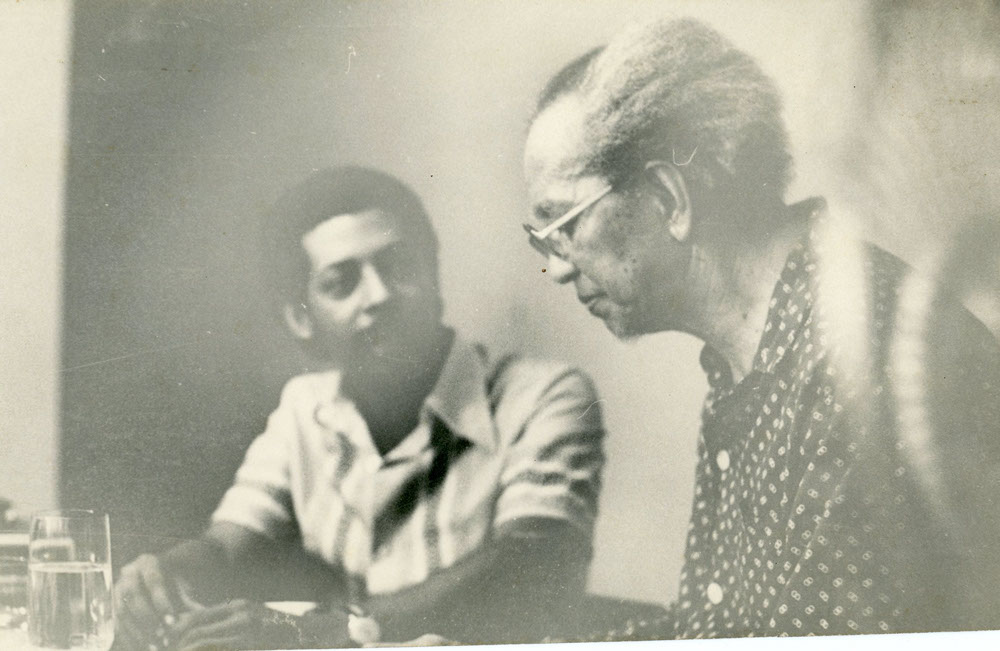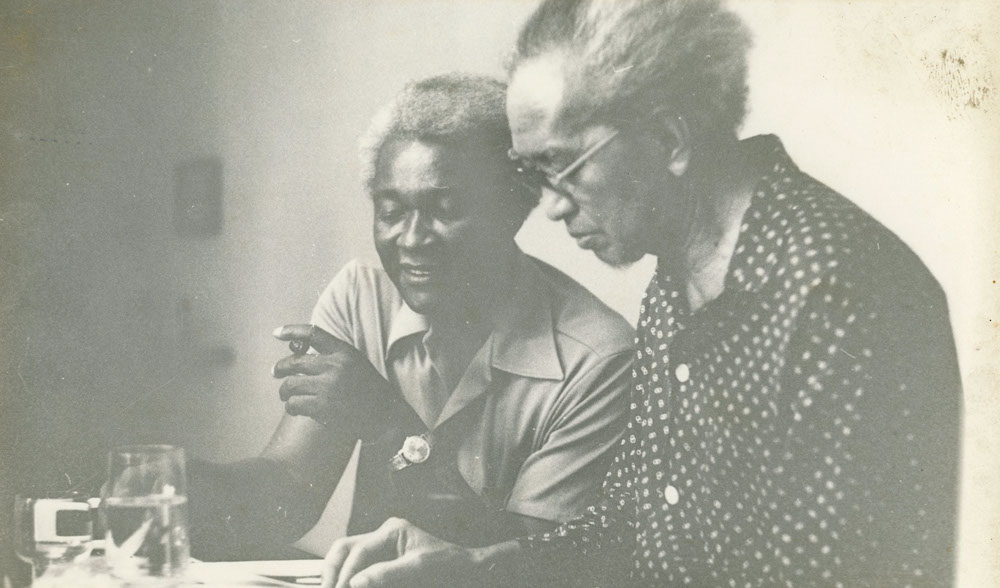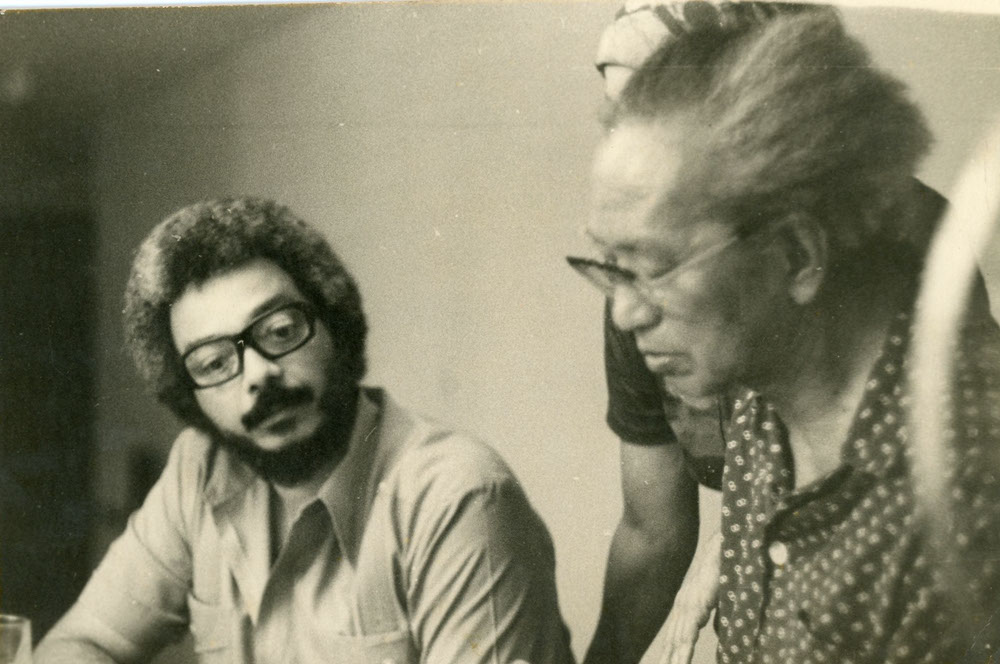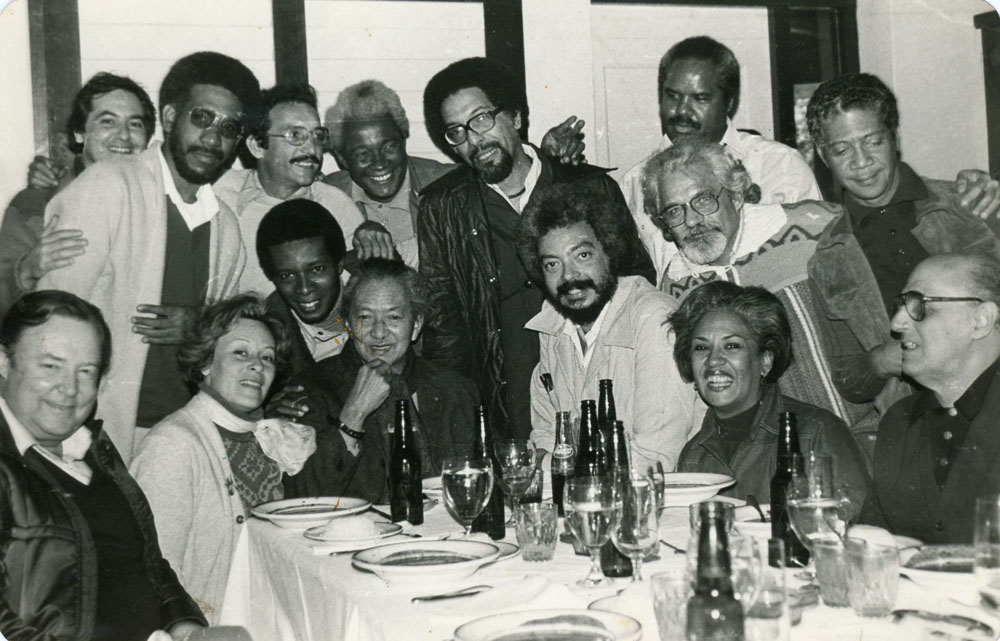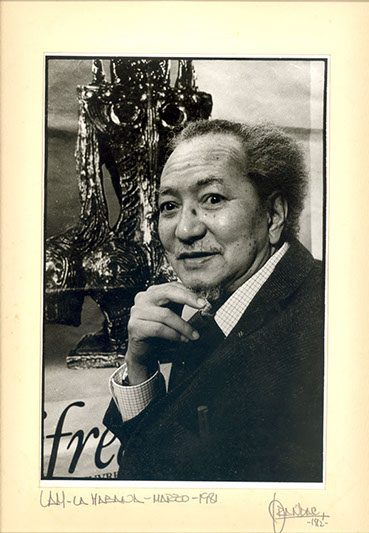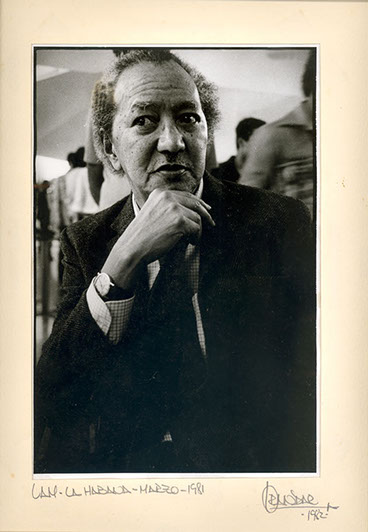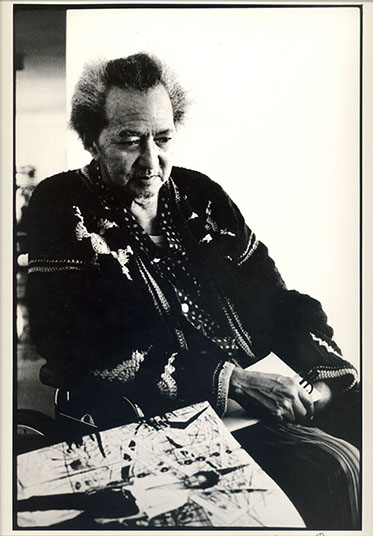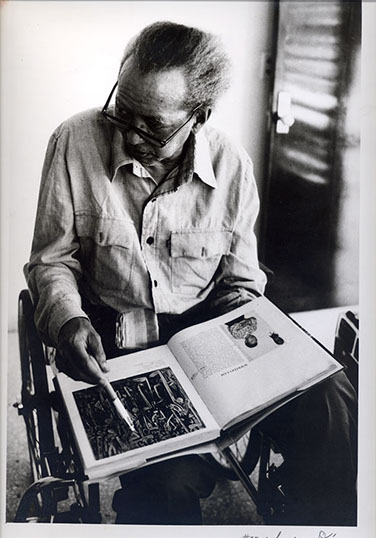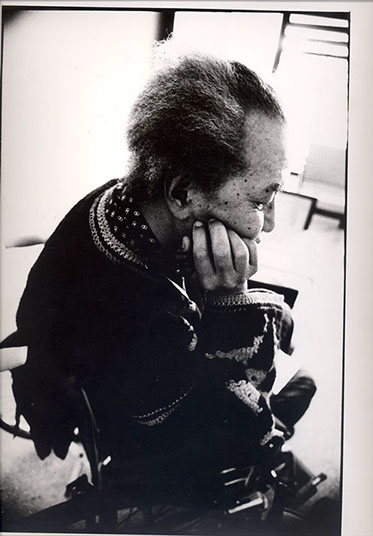Wifredo Lam: presencia de Lam en el Grupo Antillano
La visión profética de Wifredo Lam (Sagua la Grande, 1902 – París, 1982), desde los años de la década del cuarenta, empezó a crear constelaciones de creadores enlazados con diferentes discursos poéticos del Maestro. Aquellos encuentros se hicieron tangibles desde los años sesenta, cuando Lam auspició y alentó la realización del Salón de Mayo en la Habana en 1967; y de igual forma por su participación en el Encuentro Cultural de la Habana en 1968. Su aproximación a la realidad socio-cultural del país, se mantuvo alternando sus recorridos entre Francia, Italia y Cuba. En 1977 realizó la Carpeta “El último viaje del buque fantasma” compuesta por doce litografías numeradas y la incorporación de textos de Gabriel García Márquez, cuya presentación tuvo lugar en el Museo Nacional de Bellas Artes en La Habana.
Entre los años 1979-81 en una situación totalmente diferente con respecto a su estado de salud, y a su trayectoria como ser humano y como artista, Wifredo Lam ingresa en el Hospital Frank País, en Marianao. En dicho centro Lam comenzó una fase de recuperación, cuyo tratamiento estaba basado en la fisioterapia.
Desde los primeros momentos de su permanencia en dicho hospital, acompañado por su secretaria la señora Adelita Gallo, Lam comienza a recibir la visita de artistas, intelectuales, músicos vinculados a la cultura cubana. El Maestro Odilio Urfé, músico, Director del Seminario de la Música Popular, organizó algunos de esos encuentros con amigos cercanos e investigadores, como Rogelio Martínez Furé y la cantante lírica Yolanda Hernández. Otros, como Rafael Queneditt, llegaron a Lam a través de amigos comunes, como el pintor Manuel Couceiro. Queneditt explicó a Lam las actividades y propósitos de Grupo Antillano y el Maestro se interesó por el Grupo y expresó su deseo de conocer a los otros miembros.
En una de mis visitas al hospital Frank País, encontré solo a Lam e intenté más que una entrevista, una conversación; escuchándolo dialogar, más bien en un monólogo habló del teatro bufo cubano, y comentó que “el teatro bufo prolongaba la miseria.” Recordaba Lam que en una de esas representaciones en el Teatro Martí se imitaba el sonido de una locomotora y uno de los personajes en escena gritaba: “cuidado, cuidado que ahí viene el tren” y entonces el Maestro reía como un niño, con una carcajada que resultó para mí más que una sorpresa, como el despertar de una euforia, un noción de lo criollo. En otra conversación, hablamos sobre la pintura que se exponía en el Museo Nacional de Bellas Artes, y Lam afirmó “una sola raya mía, vale más que todos esos retratos de la pintura inglesa…”
La recuperación de su salud fue satisfactoria y los médicos confirmaron una evolución positiva del paciente; ello hizo posible que Lam abandonara las salas del Hospital Frank País para instalarse en una de las Casas de Protocolo de Siboney, vinculadas al Ministerio de Cultura.
En una de esas residencias de Siboney, rodeada de hermosa vegetación en la que nítidamente asomaba el sol, se le comunicó al Maestro el acuerdo del colectivo de Grupo Antillano de nombrarlo como “Presidente de Honor Vitalicio” del mismo.
En la Casa de Protocolo el ambiente se hizo más familiar, existía una euforia por la aproximación al “Icono Viviente.” Estuvieron presentes en algunas visitas, en acción con sus cámaras, el fotógrafo Ramón Martínez Grandal, en aquel entonces fotógrafo de la revista Revolución y Cultura y asimismo Mario Díaz Leyva, fotógrafo del Ministerio de Cultura. Ambos hicieron retratos en sesiones donde aparecía Lam de pie o sentado en su silla de ruedas, en soliloquios desbrozando el pasado.
“Un pintor de lo Real Maravilloso” fue el título de la exposición personal presentada por Manuel Mendive en la Galería L, en noviembre de 1980, la cual fue visitada por Lam. En aquellos momentos se desplazaba en una silla de ruedas, estando siempre acompañado por especialistas del Ministerio de Cultura. El Maestro escribió un comentario elogioso y estampó su firma en el libro de los visitantes, que Mendive conserva y guarda con profundo cariño.
En aquella etapa fueron acercándose al Maestro los artistas que siempre afirmaron en su obra la huella imperecedera de Wifredo Lam. Todo esto fue un momento de afirmación, por ello recordamos la visita a Lam a la Casa de Protocolo que hicieron Queneditt, Larrinaga, Ayala, Ocejo, Haití y Toscano, captada en una impronta cuya imagen ha quedado como testimonio permanente de lo que significó para el Grupo Antillano la presencia de Wifredo Lam; además muchos de estos creadores ya no están entre nosotros.
Por las convergencias que se producían, a veces necesarias o quizás fortuitas, el Homenaje a Wifredo Lam se realizó el día 17 de enero de 1981 en El Ranchón, un restaurant campestre. Ese día se había inaugurado la exposición “Retrato de México” en el Museo Nacional de Bellas Artes en La Habana. Coincidió además, con la realización en la Casa de las Américas, de un Recital de Poesía de la poeta afroamericana Jane Cortez, acompañada de Robert Edwards, destacado escultor, amigos cercanos a Ramón Haití, quienes también asistieron al Homenaje a Lam en el Ranchón. Su presencia junto a la de otros muchos artistas constituyó un vínculo necesario. Jane Cortez y Robert Edwards tomaron imágenes fotográficas que quizás, en algún momento pudieran ser identificadas y editadas para trabajos futuros.
El segundo Homenaje a Lam, fue presentado en la Galería Habana (Línea y F, Vedado) perteneciente al Fondo Cubano de Bienes Culturales, en marzo de 1981. En aquella ocasión se pudo apreciar la recuperación de Lam, quien se mostraba sonriente, firmando catálogos, dibujando, haciendo viñetas, determinando que el público asistente se acercara al Maestro solicitando una firma, haciendo visible con un dibujo el testimonio de aquel homenaje. Hay que poner de relieve que fue por la acción del Grupo Antillano, que pudieron realizarse aquellos homenajes, verdaderas “puestas en escena” de eventos culturales en la Ciudad de La Habana, proyectos recibidos con beneplácito por Wifredo Lam, en aquella fase de su vida, en el declinar de su salud y de sus fuerzas físicas, recibió en su país el reconocimiento que hacía décadas disfrutaba a nivel internacional.
Guillermina Ramos Cruz, 2012
The prophetic vision of Wifredo Lam (Sagua la Grande, 1902 – Paris, 1982), dating from the 1940s, began to produce constellations of artists linked to the several poetic discourses of the master. Those encounters produced tangible results starting in the 1960s, when Lam sponsored and encouraged the Salón de Mayo exhibition in Havana in 1967, and then by his participation in the Cultural Encounter of Havana in 1968. He kept in touch with the socio-cultural reality of the country while alternating his time among France, Italy, and Cuba. In 1977 he produced the portfolio “The Last Voyage of the Ghost Ship” with 12 numbered lithographs and accompanying text by Gabriel García Márquez, presented in the National Museum of Fine Arts in Havana.
In the period from 1979 to 1981, in a totally different situation with regard to the state of his health and his trajectory as a person and an artist, Wifredo Lam entered the Frank País Hospital, in Marianao. With a regimen of physiotherapy, Lam began to recover.
From the beginning of his time in the hospital, accompanied by his secretary Adelita Gallo, Lam began to receive visits from artists, intellectuals, and musicians connected to the Cuban cultural scene. Maestro Odilio Urfé, a musician who was director of the Popular Music Seminar, organized some of those meetings with close friends and scholars, such as Rogelio Martínez Furé and the opera singer Yolanda Hernández. Others, such as Rafael Queneditt, met Lam through common acquaintances such as the painter Manuel Couceiro. Queneditt explained to Lam what activities the Grupo Antillano had in mind and the master became interested in the Grupo and expressed his desire to meet the other members.
In one of my visits to the Frank País hospital I met alone with Lam and tried for a conversation rather than an interview. Listening to his dialogue, which was more like a monologue, he talked about Cuban comic theater and commented that “the comic theater prolonged poverty.” Lam recalled one of such performances in Martí Theater that included the sound of a locomotive, and one of the characters on the stage shouted “watch out, watch out, here comes the train.” Then the master laughed like a child, with a cackle that was quite surprising to me, like the awakening of a euphoria, a sense of what was Creole. In another conversation we talked about the paintings on exhibit in the National Museum of Fine Arts. Lam asserted that “a single line of mine is worth more than all those portraits by English painters...”
His recovery was satisfactory and the doctors confirmed that the patient was improving. That made it possible for Lam to leave the Frank País Hospital and move to the Minister of Culture’s protocol house in Siboney.
In one of those houses in Siboney, surrounded by beautiful vegetation with the sunshine poking through, the master was told of the Grupo Antillano’s collective agreement to appoint him as the Grupo’s Honorary President for Life.
In the protocol house there was a more casual atmosphere, excitement over getting together with the “living icon.” On some of the visits the photographer Ramón Martínez Grandal, who was at the time a photographer for the magazine Revolución y Cultura, was there with his cameras, along with Mario Díaz Leyva, a photographer at the Ministry of Culture. Both of them did portraits of sessions with Lam standing or in his wheelchair, holding forth with soliloquies about the past.
“A Painter of Magical Realism” was the title of a one-person show by Manuel Mendive in Galería L in November 1980, which Lam visited. At such times he moved about in a wheelchair, always accompanied by specialists of the Minister of Culture. In the visitor’s book the master wrote comments praising the work on display and signed his name. Mendive keeps the book with deep affection.
At that time artists who had always said that Wifredo Lam had left an everlasting mark on their work were getting to know the master. This was a moment of affirmation. Queneditt, Larrinaga, Ayala, Ocejo, Haití and Toscano all visited Lam at the protocol house, captured in a photograph that remains as permanent wit- ness of what Wifredo Lam’s presence meant to the Grupo Antillano. We should also recall that many of those artists are no longer with us.
Due to a variety of circumstances, by chance or intent, the tribute to Wifredo Lam took place on 17 January 1981 at the country restaurant El Ranchón. The “Portrait of Mexico” exhibition had its opening that day at the National Museum of Fine Arts in Havana. It also coincided with a poetry reading at the Casa de las Américas by the African-American poet Jayne Cortez, accompanied by Robert Edwards, a noted sculptor. Both were close friends of Ramón Haití, and they attended the tribute to Lam at El Ranchón. Their presence, together with many other artists, was a necessary connection. Jayne Cortez and Robert Edwards took pictures of the event that perhaps someday might be identified and published.
The second tribute to Lam took place in the Galería Habana (Línea and F, Vedado), which belonged to the Cuban Cultural Fund, in March 1981. On that occasion Lam’s recuperation was evident. He was smiling, signing catalogues, making sketches, calling the public to approach with autograph requests, and recording the event in a drawing. It should be noted that those tributes were due to the initiative of Grupo Antillano. They were truly mise-en-scène cultural events in Havana, and were well received by Wifredo Lam. At that phase of his life, in declining health and physical strength, he received the recognition in his own country that he had enjoyed for decades in international circles.
Guillermina Ramos Cruz, 2012
proyecto y curaduría:/project concept and curator: Alejandro de la Fuente
Agradecemos a la Fundación Ford por su apoyo para este proyecto /
/ Thanks to Ford Foundation for their support for this project"
web design: Los Fieras
